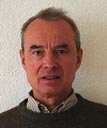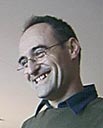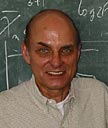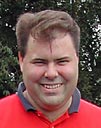- Andrzej J. BURAS, Technical University, Munich
- Juan GARCIA-BELLIDO, Universidad Autonoma, Madrid
- Conception GONZALEZ-GARCIA, Stony Brook Univ. & IFIC, Valencia
- Kurt HÜBNER, CERN, Geneva
- Dmitri KAZAKOV, JINR, Dubna
- Antonio PICH, IFIC, Universidad de Valencia
- Helmut SATZ, Universität Bielefeld
- Mike SEYMOUR, Univ. Manchester & CERN, Geneva
READING LIST
Andrzej J. BURAS, Technical University, Munich
Work Description:
The subject of my research are weak decays of K and B mesons within the Standard Model, Supersymmetry and other extensions of the Standard Model with particular emphasise put on rare and CP violating decays like $K\to\pi\nu\bar\nu$, $B_{d,s}\to \mu^+\mu^-$, $B\to \pi K$, $\epe$ and others. On the technical side my group in Munich calculated by now the NLO QCD corrections to essentially all relevant decays both in the Standard Model and Supersymmetry. On the more phenomenological side, I study the implications of these calculations and device methods to distinguish between various extensions of the Standard Model through the simultaneous study of as many processes as possible. In this context one can also determine the CKM matrix and various parameters of the physics beyond the Standard Model.
|
Title of lecture
|
Content
|
|
Flavour Physics and CP Violation
|
These lectures discuss Flavour Physics and CP Violation as seen with the help of rare and CP--violating B and K meson decays with particular emphasize put on the determination of the CKM matrix. The following topics will be discussed: i) The CKM matrix, the unitarity triangle and general aspects of the theoretical framework, ii) Particle-antiparticle mixing and various types of CP violation, iii) Standard analysis of the unitarity triangle, iv) The ratio $\epe$, v) The most important strategies for the determination of the angles $\alpha$, $\beta$ and $\gamma$ from B decays, vi) Rare decays $K^+\to\pi^+\nu\bar\nu$ and $K_L\to\pi^0\nu\bar\nu$ and vii) Correlations between non-leptonic B decays and rare decays and physics beyond the Standard Model. |
Work Description:
I do research on Early Universe Cosmology. More specifically, on models of inflation based on high energy particle physics, as well as on specific signatures that these models have on the pattern of temperature and polarization anisotropies of the Cosmic Microwave Background and the large scale structure of the universe. With the recent revolution in cosmological observations we are beginning to constrain rather stringently the main alternative models of inflation. I also do research on Reheating, the epoch in which the energy density driving inflation is converted into radiation. Recent theoretical progress in this area suggests that the process could be very non-linear, non-perturbative and very far from equilibrium, which could give rise to very interesting phenomenology, like the production of topological defects at non-thermal phase transitions, production of the primordial intergalactic magnetic fields and gravitational waves, and possibly also responsible for the origin of the matter-antimatter asymmetry.
|
Title of lecture
|
Content
|
| Cosmology and Astrophysics | These notes are intended as an introductory course for particle physicists interested in the recent developments in cosmology and astrophysics. I will describe the standard Big Bang theory of the evolution of the universe, with its successes and shortcomings, which will lead to inflationary cosmology as the paradigm for the origin of the global space-time structure of the universe. Inflation is also responsible for the generation of primordial metric perturbations that will later give rise, via gravitational collapse, to the galaxies and clusters of galaxies we see in our Hubble volume. I will review the revolution in cosmological observations, mainly the microwave background and deep galaxy redshift surveys, that has allowed cosmologists to determine the parameters of our Standard Model of Cosmology with better than a few percent errors. BIG BANG COSMOLOGY Brief introduction to general relativity Geodesics, horizons and metrics Einstein Field Equations Friedmann--Robertson--Walker universes The expansion of the universe The matter and energy content of the universe Mechanical and Thermodynamical analogies Thermal history of the universe Primordial nucleosynthesis and light element abundance Neutrino decoupling Matter-radiation equality Recombination and photon decoupling The microwave background Large scale structure formation The density contrast Linear perturbation theory The matter power spectrum DETERMINATION OF COSMOLOGICAL PARAMETERS The rate of expansion $H_0$} Cepheid variability Gravitational lensing Sunyaev-Zel'dovich effect The matter content $\Omega_{\rm M}$} Luminous matter Rotation curves of spiral galaxies Microlensing Virial theorem and large scale motion Baryon fraction in clusters Weak gravitational lensing Structure formation and the matter power spectrum Cluster abundance and evolution Massive neutrinos Axions$^*$ Weakly Interacting Massive Particles Dark Matter searches: direct and indirect The cosmological constant $\Omega_\Lambda$ Supernova Cosmology Project and SNAP The spatial curvature $\Omega_K$} Observations of the microwave background The age of the universe $t_0$ Globular clusters THE INFLATIONARY PARADIGM Shortcomings of Big Bang Cosmology The Flatness Problem The Homogeneity Problem Cosmological Inflation Homogeneous scalar field dynamics The slow-roll approximation The origin of density perturbations Gauge invariant perturbation theory Quantum Field Theory in curved space-time Quantum to Classical transition of inflationary fluctuations The anisotropies of the microwave background Acoustic oscillations in a plasma The Sachs-Wolfe effect Temperature and polarization power spectra COBE, BOOMREanG, MAP and Planck From metric perturbations to large scale structure Gravitational collapse The matter power spectrum 2dFGRS and Sloan Digital Sky Survey Reheating the universe Parametric resonance vs. perturbative decay Thermalization The origin of the matter-antimatter asymmetry Electroweak baryogenesis and Leptogenesis The global structure of the universe$^*$ Stochastic inflation and quantum cosmology Eternal inflation * This chapter lies somewhat beyond the level of a Basic Course, but could be given if time permits. |
Work Description:
My research deals with phenomenological aspects of the existing problems in particle physics. In the last years I have been mostly concentrated on the interpretation of neutrino physics results produced by experiments determining the neutrino fluxes produced in the Sun as well as in the atmosphere together with the results from terrestrial neutrino beams from accelerator and nuclear reactors.
Neutrinos have introduced the interface between particle physics, astrophysics and cosmology which I find fascinating.
|
Title of lecture
|
Content
|
| Neutrinos | Measurements of various features of the fluxes of atmospheric and solar neutrinos have provided evidence for neutrino oscillations and therefore for neutrino masses and mixing. In this lectures I will first describe the phenomenology of neutrino masses and mixing leading to oscillations in vacuum and in matter. I will then present the existing evidence from solar and atmospheric neutrinos as well as the results from laboratory searches, including the final status of the LSND experiment. I will describe the theoretical inputs that are used to interpret the experimental results in terms of neutrino oscillations and derive the allowed ranges for the mass and mixing parameters. I will also present the prospects and challenges of studying neutrino physics in approved and proposed future facilities. Finally I will briefly discuss the theoretical implications of these results: the existence of new physics, the estimate of the scale of this new physics and some lessons for different extensions of the Standard Model |

Work Description:
Current work is advising on electron-positron linear collider issues, European Spallation Source (ESS), KEK B-Factory and SPIRAL II at GANIL by participating in review and advisory bodies.
Past work on CERN Neutrino Beam to Gran Sasso (CNGS), Large Electron and Positron storage ring (LEP), Compact Linear Collider (CLIC) study, LHC study, PETRA storage ring, SPEAR and PEP storage ring, Intersecting Storage Ring (ISR). The work was centered on design of accelerators with emphasis on accelerator physics.
|
Title of lecture
|
Content
|
| Accelerators | I. Basics in accelerators 1.1 Linear Accelerators (types of accelerating structures, key parameters) 1.2 Beam Dynamics for linear accelerators 1.3 Cyclotrons (classical cyclotrons, synchro-cyclotrons, isochronous cyclotrons) 1.4 Synchrotrons (Basic layout, key components, examples) 1.5 Storage rings (examples) 1.6 Linear Beam Dynamics for circular accelerators (transverse and longitudinal motion) II. Future Accelerators (key issues and advanced technology) 2.1 Large Hadron Collider (LHC) (magnet, cryogenics and vacuum technology) 2.2 Very-Large Hadron Collider (VLHC) (magnets and other key issues) 2.3 Linear Electron-Positron Collider (basic technologies and selected beam dynamics issues) 2.4 Neutrino Beams (conventional, super-beams, neutrino factories) 2.5 Muon-muon collider |
Work Description:
My main research interests in recent time have been concentrated around supersymmetric models of quantum field theory and their phenomenological application in particle physics and cosmology.
I have been studying the renormalization properties of gauge field theories in extra dimensions with the aim to construct a consistent quantum field theory.
We have been also continuing the analysis of the Minimal Supersymmetric Standard Model subjected to various theoretical and experimental constraints including those coming from the Dark matter search. We performed the analysis of recent astrophysical data taking into account the neutralino contribution to the Dark matter in order to reconstruct the profile of the Dark Matter in our Galaxy.
|
Title of lecture
|
Content
|
| Beyond the Standard Model | Part I: Supersymmetry Introduction: What is supersymmetry Motivation of SUSY in particle physics Basics of supersymmetry SUSY generalization of the Standard Model. The MSSM Breaking of SUSY in the MSSM Constrained MSSM The Higgs boson mass in the MSSM Perspectives of SUSY observation Part II: Extra Dimensions The main idea of extra dimensions Brane-world models Possible experimental signatures of ED |
Work Description:
Phenomenology of electroweak and strong interactions. Effective field theory
(Chiral Perturbation Theory, Heavy Quark Effective Theory, ...).
Flavour dynamics (flavour-changing transitions, Kaon physics, D and B decays, Tau physics, ...). CP violation.
|
Title of lecture
|
Content
|
|
Field Theory and the Standard Model |
The Standard Model of Elementary Particle Physics will be described. A detailed discussion of the particle content, structure and symmetries of the theory will be given, together with an overview of the most mportant experimental facts which have established this theoretical framework as the Standard Theory of particle interactions. 1.- Gauge Theories: QED, QCD 2.- Electroweak Unification: SU(2)_L x U(1)_Y 3.- Symmetry Breaking: Higgs Mechanism 4.- Electroweak Phenomenology 5.- Flavour Structure of the Standard Model |
Work Description:
The central topics of my present work are the thermodynamics of strongly interacting matter and the study of high energy nuclear collisions.
Strong interaction thermodynamics is today defined by statistical QCD and shows for increasing temperaturea and/or densities a transition from hadronic matter to a plasma of deconfined quarks and gluons.
The nature and the properties of this transition have to be determined, and its experimental consequences identified.
The aim of high energy nuclear collisions is to study deconfinement in the laboratory. This implies both initial state partonic aspects, which through parton percolation can lead to geometric critical behaviour, and possible subsequent thermalization with quark-gluon plasma formation. Here again experimentally accessible signals of the different evolution stages are of primary importance.
|
Title of lecture
|
Content
|
| Quark Deconfinement and Nuclear Collisions | 1) States of Matter in QCD 2) Parton Configurations in Nuclear Collisions 3) Probes of Thermal Conditions 4) Probes of Initial Stage Conditions 5) Experimental Status: Questions and Answers |
Work Description:
The phenomenology of QCD, the Standard Model and sometimes a little bit beyond. General methods for next-to-leading order jet calculations and work towards next-to-next-to-leading order. Some specific implementations of those methods for e+e- annihilation, DIS and hadron-hadron collisions. All-order resummation of jet properties and event shapes. Design and implementation of improved jet algorithms, especially for hadron-hadron collisions. Monte Carlo algorithms for simulating parton showers, hadronization and underlying events. The HERWIG and HERWIG++ event generators. Close cooperation with experimenters to optimize the use of HERWIG and other theoretical tools for data analysis.
|
Title of lecture
|
Content
|
|
QCD |
1) Introduction to QCD: quarks and gluons similarities with QED introduction to QED gauge invariance SU(3) and colour Lagrangian Feynman rules running coupling quark masses, scale invariance and decoupling 2) QCD at tree level: e+e- annihilation cross section deep inelastic scattering the parton model hadron collisions jet production 3) Beyond tree level: e+e- annihilation at one-loop dimensional regularization loop integrals phase space integrals DIS revisited factorization evolution quark masses definition running pole mass large logarithms - preview 4) All-order calculations: renormalization as resummation evolution as resummation two-scale problems event shapes threshold cross sections energy flows and 'rapidity gaps' 'non-global' logarithms jet algorithms jet, sub-jet and hadron multiplicity distributions 5) Monte Carlo techniques: parton shower algorithms final state initial state confinement and hadronization hadronization models |
- Andrzej J. BURAS, Technical University, Munich
The suggested literature is given in
cite{REV,Schladming,Cracow}.
begin{thebibliography}{80}
bib item {REV}
R. Fleischer,
“CP violation in the B system and relations to $K \to \pi \nu \bar\nu$ decays”
Phys. Rep.~ 370 (2002) 537
hep-ph/0207108
A.J. Buras,
”CP violation in B and K decays: 2003”
hep-ph/0307203
bib item {Cracow}
A.J. Buras,
”Minimal flavor violation”
TUM-HEP-530-03, hep-ph/0310208
- Juan GARCIA-BELLIDO, Universidad Autonoma, Madrid
Suggested reading:
- S. Weinberg, ”Gravitation and Cosmology”, John Wiley & Sons (1972)
- E.W. Kolb & M.S. Turner, “The Early Universe”, Addison Wesley (1990)
- A.D. Linde, “Particle Physics and Inflationary Cosmology”, Harwood Academic Press (1990)
- P.J.E. Peebles, “Principles of Physical Cosmology”, Princeton U.P. (1993)
- T. Padmanabhan, “Structure Formation in the Universe”, Cambridge U.P. (1993)
- T. Padmanabhan, “Cosmology and Astrophysics through Problems”,Cambridge U.P. (1996)
- J.A. Peacock, “Cosmological Physics”, Cambridge U.P. (1999)
- A.R. Liddle & D.H. Lyth, “Cosmological Inflation and Large Scale Structure”, Cambridge U.P. (2000)
- J. Garcia-Bellido, “Astrophysics and Cosmology”, hep-ph/0004188, ESHEP 1999, CERN report 2000-007.
- S. Carroll, “Lecture Notes on General Relativity”, gr-qc/9712019.
Also at the web page: http://pancake.uchicago.edu/carroll/notes/Particle Data Group, http://pdg.web.cern.ch/pdg/}
Back to top of READING LIST
- Concepcion GONZALEZ-GARCIA, Stony Brook Univ. & IFIC, Valencia
Suggested reading:
BOOKS:
-General Particle Physics Level Required:
Halzen, F and Martin, A . Quarks and Leptons, (Wiley 1984)
-Neutrino physics
- Bahcall, J.N., Neutrino Astrophysics, (Cambridge University Press, Cambridge, 1989).
- Kim, C.W. and A. Pevsner, Neutrinos in Physics and Astrophysics, (Contemporary Concepts in
Physics, Vol. 8, Harwood Academic Press, Chur, Switzerland, 1993)
- Mohapatra, R N; Pal, Palash B. Massive neutrinos in physics and astrophysics
(World Scientific Lecture Notes in Physics 60, 1998)
RECENT REVIEW ARTICLES:
- Gonzalez-Garcia,M.C. and Nir,Y. Neutrino Massesa and Mixing: Evidence and Implications, Rev.Mod.Phys.75, 345 (2003) hep-ph/0202058
- Barger,V., Marfatia,D., and Whisnant,K., Progress in the physics of massive neutrinos,
Int. J. Mod. Phys.E12, 569 (2003) hep-ph/0308123
Back to top of READING LIST
- Kurt HUBNER, CERN, Geneva
Suggested reading:
Books
-- The physics of particle accelerators: an introduction / WILLE, Klaus - Oxford: Oxford Univ. Press, 2000.- 315 p
-- Particle accelerator physics I: Basic principles and linear beam dynamics/WIEDEMANN Helmut
Springer-Verlag, 2nd edition, 2003, 449 p
-- Principles of rf linear accelerators/ WANGLER, Thomas P. - NY Wiley, 1998, 382 p (chapters 1-6)
School Proceedings
-- CAS - CERN Accelerator School : Cyclotrons, Linacs and Their Applications , 28 Apr - 5 May 1994 , LaHulpe, Belgium /TURNER, Stuart (ed.)
Proceedings in Report CERN-96-02. Contribution by P.Lapostolle, D.Warner and M.Weiss on linear accelerators
see: http://preprints.cern.ch/cgi-bin/setlink?base=cernrep&categ=Yellow_Report&id=96-02
-- General Accelerator Physics Course , 7 - 18 Sep 1992 , Jyväskylä, Finland /TURNER, Stuart (ed.)
Proceedings in Report CERN-94-01-Volume 1. Contribution by J.Rossbach, P.Schmüser, and J.Buon on beam optics;
see: http://preprints.cern.ch/cgi-bin/setlink?base=cernrep&categ=Yellow_Report&id=94-01_v1
-- International School of Physics “Enrico Fermi”, CLII Course, Neutrino Physics, Varenna, 2002
Contribution by K.Hübner on accelerator-based neutrino beams, also report CERN-AB-2003-082-ADM; Geneva : CERN, 25 Aug 2003 2002 . - 9 p
see http://cdsweb.cern.ch/search.py?p=varenna20020723&f=962__n
Back to top of READING LIST
- Dmitri KAZAKOV, JINR, Dubna
Suggested reading
1. S.Weinberg, "The quantum theory of fields. Vol. 3: Supersymmetry", Cambridge, UK: Univ. Press, 2000.
2. D.I.Kazakov, "Beyond the Standard Model (In search of supersymmetry)", Lectures at the European school on high energy physics, CERN-2001-003,
3. Yu.A.Kubushin, Models with Extra Dimensions and Their Phenomenology, hep-ph/0111027.
4. J.Hewett and M.Spiropulu, Particle Physics Probes of Extra Spacetime Dimensions, hep-ph/0205106
Back to top of READING LIST
- Antonio PICH, IFIC, Universidad de Valencia
Suggested Reading:
-"Quantum Field Theory", F. Mandl and G. Shaw (John Wiley, 1984)
-"Gauge Theories in Particle Physics", I.J.R. Aitchison and A.J.G. Hey
(Third Edition, 2003, Institute of Physics Publishing).
Standard Model:
- A. Pich, "The Standard Model of Electroweak Interactions", arXiv:hep-ph/9412274
- A. Pich, "The Standard Model of Particle Physics: Status & Low-Energy Tests",
arXiv:hep-ph/0206011
- A. Pich, "The Standard Model of Particle Physics", 2003 CERN Summer Student Lectures,
http://agenda.cern.ch/tools/SSLPdisplay.php?stdate=2003-06-30&nbweeks=7
Back to top of READING LIST
- Helmut Satz, Universität Bielefeld
F. Karsch and H. Satz (Eds.), Proceedings of the International Symposium on Statistical QCD, Nucl. Phys. A 702 (2003).
H. Satz, Color Deconfinement in Nuclear Collisions, Rept. Progr. Phys. 63 (2000) 1511.
H. Satz, Limits of Confinement, Nucl. Phys. A 715 (2003) 3.
H. Satz, Deconfinement and Percolation, Nucl. Phys. A 642 (1998) 130.
Back to top of READING LIST
- Mike SEYMOUR, Univ. Manchester & CERN, Geneva
Suggested Reading:
Proceedings of previous schools, especially:
A QCD Primer, G. Altarelli, lectures given at 2001 European School of High-Energy Physics, Beatenberg, Switzerland, 26 Aug - 8 Sep, 2001 [hep-ph/0204179].
Perturbative QCD, W.J. Stirling, lectures given at 1999European School of High-Energy Physics, Casta-Papiernicka, Slovak Republic, 22 Aug - 4 Sep 1999.
The best book on the subject is:
QCD and Collider Physics, R.K. Ellis, W.J. Stirling and B.R. Webber.
Background information can also be obtained from:
Quarks and Leptons: An Introductory Course in Modern Particle Physics, F. Halzen and A.D. Martin.
An Introduction to Quantum Field Theory, M.E. Peskin and D.V. Schroeder.
Back to top of READING LIST






